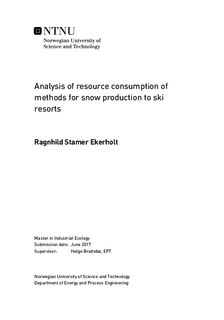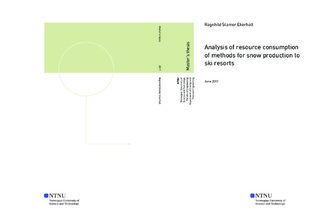| dc.description.abstract | This thesis is a case study of Granåsen ski arena in Trondheim. It considers the environmental impacts from operating a 5 km track from November 1st to April 30th, analyzing three different alternatives and a few variations of these. The three main alternatives are:
- Alternative A: snow is produced in season one, stored over summer, and distributed into the tracks at the beginning of season two.
- Alternative B: temperature independent ice production is running from August to season opening, creating e.
- Alternative C: a combination of snow production in addition harvesting of snow from tracks at the end of season one is stored over summer and distributed into the tracks at the beginning of season two.
All alternatives do also include operation of tracks during the season, involving replenishment and grooming. The environmental impacts are considered with respect to global warming potential (GWP) and local air pollution, measured in NOx and particulate matter. Electricity use is also considered in all alternatives. The study is conducted using LCA methodology, and the inventory is built on information from the operation team in Granåsen and literature study.
The most efficient alternative in terms of GWP is alternative C. In this alternative, 24,9 ton CO2-eq is emitted during the entire season. Environmental impacts from alternative A and C are similar, but slightly higher environmental impacts occur when harvesting is replaced with snow production. Regarding local air pollution, alternative C is also considered the best option. An alternative based on ice production leads to significantly higher emissions, with 214,4 ton CO2-eq at most.
Impacts on GWP is strongly correlated to electricity use, which is also the most influencing parameter studied. Energy intensive processes that reduces the amount of labor hours are therefore associated with higher emissions, in general. A valuation of labor use versus environmental impacts are therefore a matter of choice and should be done by decision makers. | |

